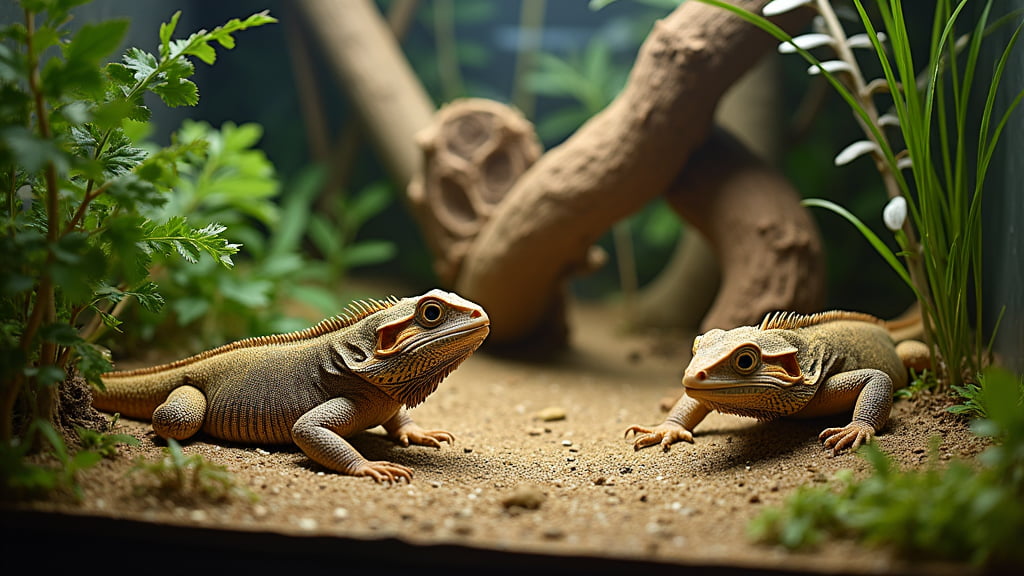Welcome to the fascinating world of bioactive habitats for your Bearded Dragon! If you’re looking to elevate your pet’s living environment and create a more naturalistic setup, this guide will take you through the steps of creating a thriving bioactive habitat—one that mimics your dragon’s native Australian landscape.
What is a Bioactive Habitat?
A bioactive habitat is an ecosystem within your terrarium that sustains itself with minimal maintenance. Picture a slice of nature: living plants, nutritious soil, beneficial insects, and your Bearded Dragon, all coexisting in harmony. As someone who has set up several of these habitats, I can tell you that they do wonders for your dragon’s health and enrichment.
Why Choose a Bioactive Habitat for Your Bearded Dragon?
Health Benefits
Creating a bioactive environment enhances your dragon’s well-being in numerous ways:
- Natural Behaviours: It encourages natural dig and forage behaviours.
- Stable Microclimate: It helps maintain consistent humidity and temperature levels.
- Cleaner Environment: Beneficial bugs break down waste, promoting a cleaner enclosure.
Environmental Enrichment
- Mental Stimulation: A diverse, interactive environment reduces stress and promotes mental health.
- Natural Scents and Textures: Different elements like soil and plants provide variety in texture and smell, making your Bearded Dragon feel right at home.
Setting Up Your Bioactive Habitat
Choosing the Right Terrarium
Size and Material
When selecting a terrarium, ensure it is spacious enough for your dragon to move around freely. A 120-gallon glass enclosure is ideal for an adult Bearded Dragon. If starting with a juvenile, you may opt for a 40-gallon tank but be prepared to upgrade as they grow.
Ventilation
Proper ventilation is crucial to prevent mould and bacterial growth. A mesh top or side vents work wonderfully to keep fresh air circulating.
Substrate Layers
The substrate is the foundation of your bioactive habitat. Here’s a tried-and-true layering method I swear by:
Drainage Layer
Start with a layer of clay pebbles or hydroballs. This ensures excess water drains away from the soil, preventing root rot.
Separator Layer
Use a piece of fine mesh or landscape fabric to keep the soil from mixing with the drainage layer.
Soil Mix
Create a soil mix rich in nutrients:
- 40% organic topsoil
- 30% coconut coir
- 20% play sand
- 10% organic compost
Ensure the mix is pesticide-free and well-aerated.
Live Plants
Opt for hardy, drought-tolerant plants that can thrive under UVB light. Great choices include:
- Jade Plants
- Aloe Vera
- Pothos
Plants not only beautify the enclosure but also serve practical purposes. They aid in humidity regulation and provide natural hiding spots for your dragon.
Introducing Microfauna
A Cleaning Crew
Adding beneficial insects such as isopods and springtails helps break down organic waste, reducing the need for frequent deep cleans.
Isopods
These tiny crustaceans are excellent decomposers. They consume detritus and promote soil health.
Springtails
These insects keep mould in check by consuming fungal spores, maintaining a balanced ecosystem.
Maintaining Your Bioactive Habitat
Routine Maintenance
While the bioactive setup significantly reduces the cleaning workload, some upkeep is necessary:
- Daily: Spot clean visible waste.
- Weekly: Lightly mist plants and inspect them for any signs of distress.
- Monthly: Replace or trim any dead plants to ensure a healthy microhabitat.
Monitoring Environmental Parameters
Keep an eye on your habitat’s temperature, humidity, and lighting:
- Temperature: 24-35°C (75-95°F)
- Humidity: 30-40% (native aridity)
- UVB Lighting: Ensure it covers 50-75% of the tank
Conclusion
Creating a bioactive habitat for your Bearded Dragon is a rewarding experience, offering numerous benefits for both you and your pet. Not only does it create a more enriching environment, but it also allows you to enjoy a slice of nature within your home. Should you encounter any health issues with your Bearded Dragon, always consult a qualified vet for advice.
For more insights and tips, check out our posts on Bearded Dragon Habitat and Optimal Bearded Dragon Lighting.
Meta Description
Learn how to create a thriving bioactive habitat for your Bearded Dragon! Our detailed guide covers everything from substrate layers to plant selection and routine maintenance, ensuring your pet’s environment is both natural and enriching.
By following this guide, you’ll transform your Bearded Dragon’s habitat into a vibrant mini-ecosystem, contributing to their overall happiness and health. Happy herping!

